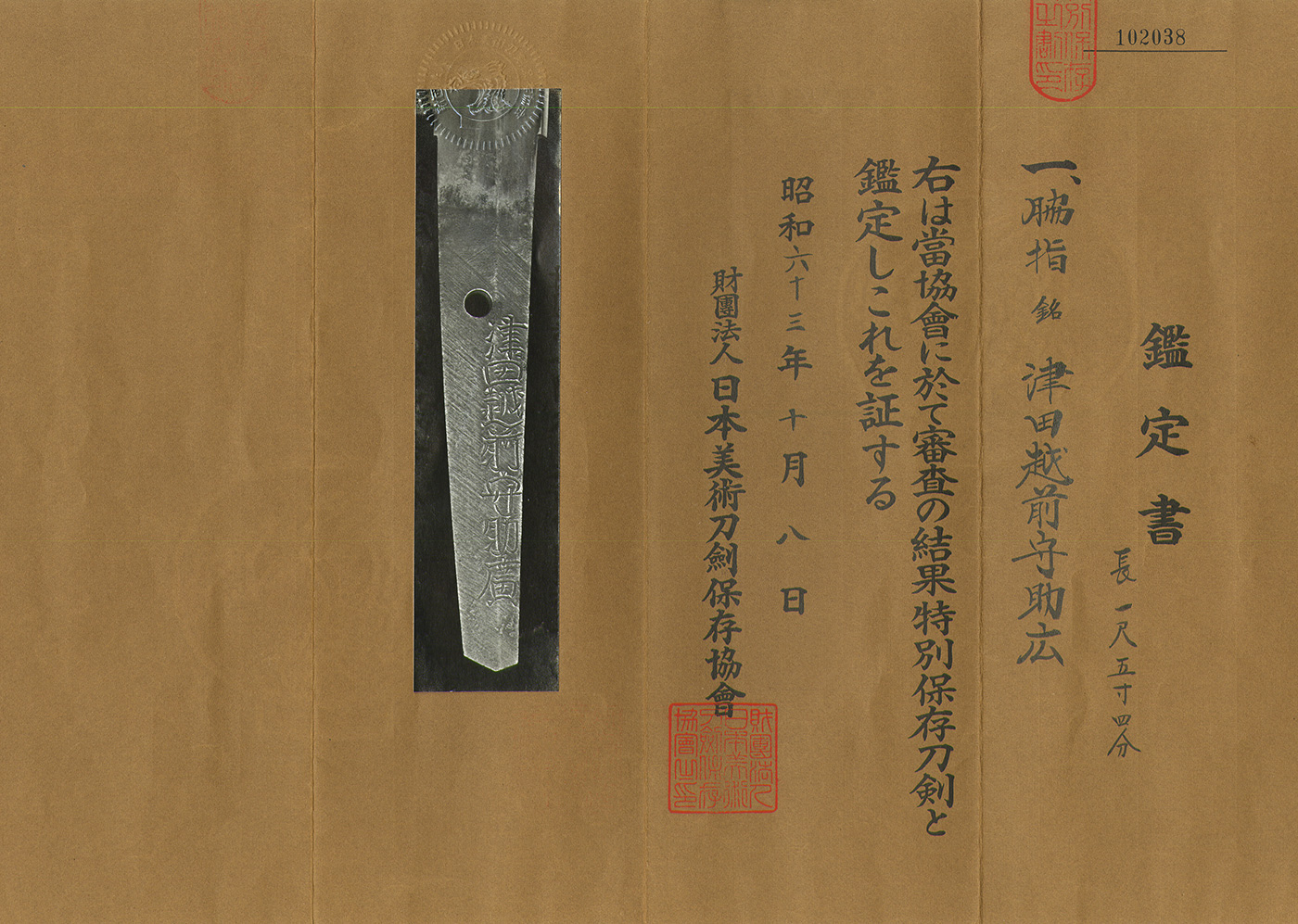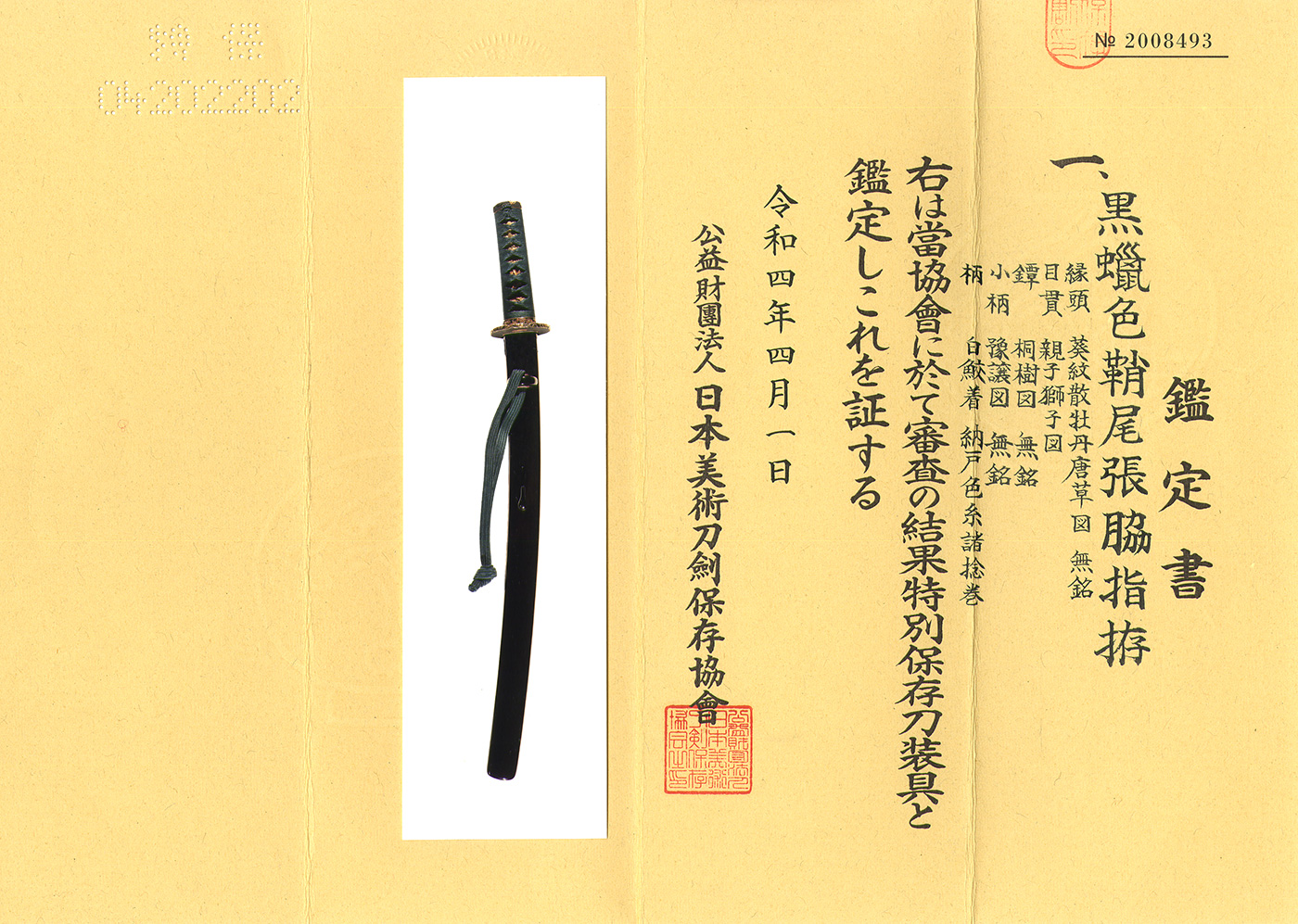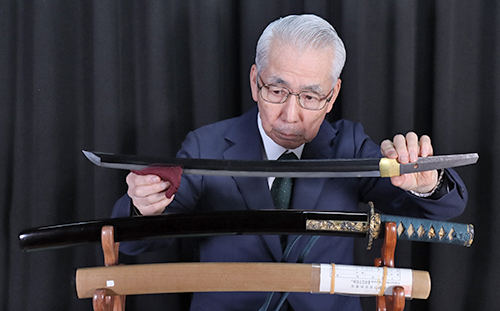Ordering number:23794
Wakizashi in Shirasaya with Koshirae (NBTHK Tokubetsu Hozon Token)(Koshirae: NBTHK Tokubetsu Hozon Tosogu)
Signature: Tsuda Echizen no Kami Sukehiro
津田越前助広
(We divide 4 sections for each sword as Saijyo saku, Jyojyo saku
Jyo saku and regular saku)
This blade belongs to Jyo Jyo Saku ranking.
The blade has been polished.
Blade length: 46.5 cm (18.31 in)
Curvature: 0.9 cm (0.35 in)
Mekugi Hole: 1
Width at Base: 2.87 cm (1.13 in)
Width at the tip: 2.1 cm (0.83 in)
Thickness of rim (Kasane): 0.8 cm (0.31 in)
Sword Weight: 495g
Era:the Edo period around Enpo(around 1673)
Shape: The sword has a slightly wider body and thicker rim than usual, maintaining a standard shape.
Jigane: Well-refined small itame hada creating a beautiful jigane.
Hamon: The hamon has a deep nioiguchi with frequent ko-ashi and a rounded boshi.
Features: Sukehiro holds an extremely important position among Osaka Shinto swordsmiths. There were two generations of Sukehiro, and this work is by the second generation. The first generation Sukemasa, originally from Harima, later moved to Osaka and was an apprentice to Kawachi no Kami Kunisuke, commonly known as “Soboro Sukehiro.” He was known for his excellent cutting ability and was designated as a Saijyo Owazamono. He received the title of Echizen no Kami later in his life and passed away in 1663. The second generation was a student of the first generation, received his title in 1661, and in 1667, was employed by Aoyama Inaba no suke Munetoshi, the lord of Komoro Castle in Shinshu. He started signing his name “Tsuda Echizen no Kami Sukehiro” in regular script from February of that year and changed to a cursive style signature called Marutsuda in August 1674. He died in 1682. This work is characterized by its excellent shape, refined jigane, and the hamon that is both tight and plump.
Koshirae:
Tsuba: A heavy round shakudo nanako with a high-relief plant pattern in gold.
Fuchikashira: Shakudo nanako with a high-relief peony design in gold. The head is carved in high relief in gold and shakudo.
Saya (Scabbard): Black roiro saya.
Menuki: High-relief design of a lion in solid gold (?).
Kozuka: Features a mounted warrior and chrysanthemum flowers, a luxurious design.
Kogai: The groove of the kogai is carved, making the signature visible.
Seppa: Two pieces made of copper with a gold wrap.
Aoi Art’s Comment: Following the first generation Sukehiro, around the Manji period, there were attempts to imitate his works. However, later works like this one exhibit midareba and sunagashi that are highly appreciated by many sword enthusiasts for their finished tumultuous hamon patterns. This piece, completed through such a distinguished process, overflows with activity, reminiscent of sunlight filtering through the morning mist in a forest during an early walk. It is a highly esteemed piece for its exquisite jigane and hamon. The beauty of the wakizashi’s jigane and the wildness of its hamon are indeed spectacular. The koshirae is also well-crafted, with a gentle yet superior nioiguchi. This work by Tsuda Echizen no Kami Sukehiro features a deep nioiguchi with a direct hamon and ko-ashi entering deeply, rounding off at the tip. The koshirae is luxurious and likely belonged to a highly ranked or wealthy individual. This is a recommended piece, housed in a lavish koshirae.
NBTHK Tokubetsu Hozon Token
Koshirae: NBTHK Tokubetsu Hozon Tosogu
AoiArt estimation paper
Whole Oshigata







